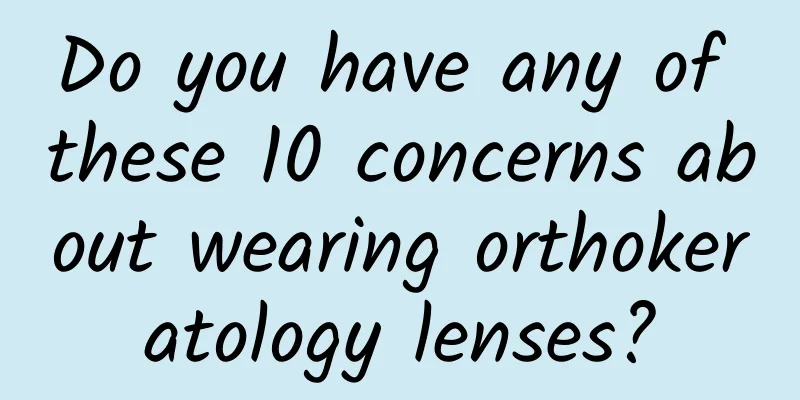Do you have any of these 10 concerns about wearing orthokeratology lenses?

|
Many parents want to choose orthokeratology lenses for their children to inhibit the rapid progression of myopia, but after all, it is a "contact lens" worn at night, so many parents still have many concerns. Today, Wuhan University Aier Eye Hospital will eliminate the "top ten concerns you are worried about" for you. Concern 1: Orthokeratology lenses are a type of contact lens. Can children do it by themselves? To wear orthokeratology lenses, the age requirement is 8 years old or older. If the child has a certain degree of self-care ability, he or she can learn to take off and wear the lenses and take care of them by himself or herself. If the child is relatively young and cannot operate independently, the parents can also operate on his or her behalf, wearing them before going to bed at night and taking them off after waking up in the morning. Concern 2: What kind of discomfort may occur in the eyes after wearing orthokeratology lenses? How to deal with it? The orthokeratology lenses worn at night are worn on the cornea like a mold when sleeping, and the cornea is reshaped during sleep. After taking them off, the center of the cornea becomes flat and the periphery of the cornea becomes steeper, so that you can see clearly during the day. However, this is a gradual process. In the early stage of wearing the lenses, you may see double vision, unstable vision (for example, your vision may decline in the afternoon), a mild foreign body sensation, and slightly more eye secretions. These are all normal and very common reactions in the early stage of wearing orthokeratology lenses. Parents do not need to worry too much. As we wear the lenses for a longer time, generally after a week of wearing them, the refractive power gradually becomes stable, and these symptoms will gradually disappear. Concern 3: Orthokeratology lenses are worn directly on the child's cornea. Will they increase the chance of eye infection? According to most domestic and foreign literature reports, the incidence of corneal infection caused by wearing orthokeratology lenses is about 4 in 10,000, which is relatively low. And compared with ordinary soft contact lenses, orthokeratology lenses do not increase the risk of corneal infection. Most of the adverse reactions to contact lenses in clinical practice are caused by improper care, and orthokeratology lenses are no exception. Therefore, it is important to pay attention to correct wearing and careful care, so as to reduce the risk of eye infection to a minimum. However, it is also reminded that if the child has eye pain, red eyes, fear of light, tears, etc. after wearing the glasses, he must stop wearing them immediately, and go to the hospital for a follow-up visit in time, and the doctor will make a correct judgment and treatment. Concern 4: Will long-term wearing of orthokeratology lenses affect the development of children's eyes? The growth of children's height and excessive use of eyes at close range will cause the length of the eye axis to grow rapidly. However, wearing orthokeratology lenses will reshape the shape of the front surface of the cornea, making the center flatter and the periphery steeper. Due to this special shape change, it can not only ensure the central retinal imaging, but also make the peripheral objects also imaged on the retina, or even fall in front of the retina, playing a role in controlling and slowing down the growth of the eye axis. Isn't this what parents want, to only grow taller and less eye axis? Concern 5: Orthokeratology lenses are a type of contact lens that will cause the cornea to "suffocate"? Some contact lenses are made of airtight materials, which can easily cause corneal hypoxia and inflammation. Although orthokeratology lenses are a type of contact lens, they are very different from other contact lenses. In terms of material, they are hard contact lenses and use a material with good oxygen permeability, which will not cause corneal hypoxia. The thickness of traditional orthokeratology lenses is between 0.22-0.25mm. The lenses are thin and light, and there is no foreign body sensation when wearing them. The oxygen permeability value can generally reach more than 100, which is higher than the 90 oxygen permeability required for night-wear contact lenses stipulated by the state. It is a highly oxygen-permeable material. Most ordinary contact lenses have an oxygen permeability value of about 50, and low oxygen permeability will affect the breathing of the eyes. Concern 6: Will the cornea become thinner after wearing orthokeratology lenses for a long time? After wearing orthokeratology lenses, the central corneal epithelial cells migrate to the mid-periphery, the central part becomes thinner, and the mid-periphery becomes thicker. After the shaping is completed, it stabilizes and does not continue to thin. After stopping wearing, it returns to its original thickness. The thickness of a normal person's cornea is 500 to 550 microns. After shaping, the cornea becomes 8 to 9 microns thinner. Such a change in thickness should be considered minimal. Concern 7: Generally, orthokeratology lenses are required to be worn for 8 to 10 hours, but some children have a heavy academic burden and sleep less than 8 hours. Can they still wear them? This depends on the child's vision after taking off the glasses the next day. If the child does not wear the glasses for 8 hours, but can meet his daytime vision needs, then there is no need to extend the wearing time. If some children with higher degrees cannot meet their daytime vision needs after wearing the glasses for less than 8 hours, they can also wear the glasses earlier. For example, wearing the lenses two hours in advance to do homework can help you see clearly on the one hand, and on the other hand, it can also improve your vision after wearing the glasses during the day. Concern 8: My child likes to sleep in, so he may wear the lenses for more than 10 hours. Can I let him wear the orthokeratology lenses one day less per week? For children with low myopia or some adult wearers, stopping wearing glasses for one night does not have a significant impact on the vision of the next day, and they can take a break one night a week. However, for adolescent wearers who hope to better slow down the rapid growth of myopia, stopping wearing glasses does have an impact on the effect of myopia control. Therefore, it is generally recommended to wear glasses every night. Concern 9: My child is wearing orthokeratology lenses now. Will he have the chance to have myopia surgery when he grows up? After many studies, it was found that the density and morphology of corneal endothelial cells in human eyes did not change whether it was the first day of wearing orthokeratology lenses or after wearing them for 5 consecutive years. This shows that orthokeratology lenses can maintain the normal physiological structure and function of the cornea, and will not cause any irreversible changes to the cornea. If adults still want to continue myopia surgery, they usually only need to stop wearing them for 3 to 6 months, wait for the cornea to completely recover to its basic shape before wearing, and then undergo relevant examinations and surgeries. Concern 10: Can orthokeratology lenses be rinsed with boiled water? Director Zhou Chao of the optometry department of Aier Eye Hospital affiliated to Wuhan University kindly reminds: There are often some misunderstandings in the care of orthokeratology lenses. People don’t know whether they can be worn directly after rinsing with care solution, or whether they need to be rinsed with boiled water or other liquids. Recently, the State Food and Drug Administration issued the "Guidelines for the Preparation of Instructions for Rigid Gas-Permeable Contact Lenses for Orthokeratology (2020 Revised Edition)", which clearly stipulates that "it is forbidden to use any other liquids (such as tap water, cold boiled water, distilled water, soft lens care solution, etc.) to care for the lenses, otherwise it may cause eye inflammation and affect the service life of the lenses!" |
<<: People with allergic asthma should not eat these seven types of food
>>: What are the benefits of drinking red wine before bed? How to choose the right red wine for you
Recommend
Leukocytic white blood cells 20
Leucorrhea cells 2+ is a phenomenon of leukocytos...
Clothing matching for short, fat and thick-legged girls
For some women, because of their thick legs and s...
Comment | Replacing daughter's antidepressant with vitamins reflects the urgent need to improve public health literacy
"The mother stopped giving her daughter anti...
If there is no stringy leucorrhea during ovulation, does it mean that ovulation has not occurred?
Ovulation is a unique physiological stage for wom...
Is it a boy if you have an erotic dream in late pregnancy?
During pregnancy, pregnant mothers must be very c...
Can I have sex if I have vaginitis?
After getting vaginitis, you should first go to t...
Causes and precautions of sweating after abortion
Abortion is really harmful to the body. In daily ...
How to determine amenorrhea
Most women think that amenorrhea means menopause....
How many days should I take anti-inflammatory drugs after an abortion?
Women's bodies will be inflamed after abortio...
What is a gynecological bimanual examination?
I believe everyone knows the importance of gyneco...
Summer waves? Remember to hide from these two "killers"!
Source: Ni Xiaojiang & Jing'an CDC...
White spots on chest
In life, some women will have some white spots on...
What's wrong with vaginal bleeding other than menstruation?
Menstrual bleeding for female friends is a very n...
Cervical cancer stages and survival rates
Cancer is a very complex disease and the symptoms...
Reduce the number of window openings for ventilation in winter and follow the "Seven Musts" for home cleaning and disinfection
The weather is cold in winter, people open window...









